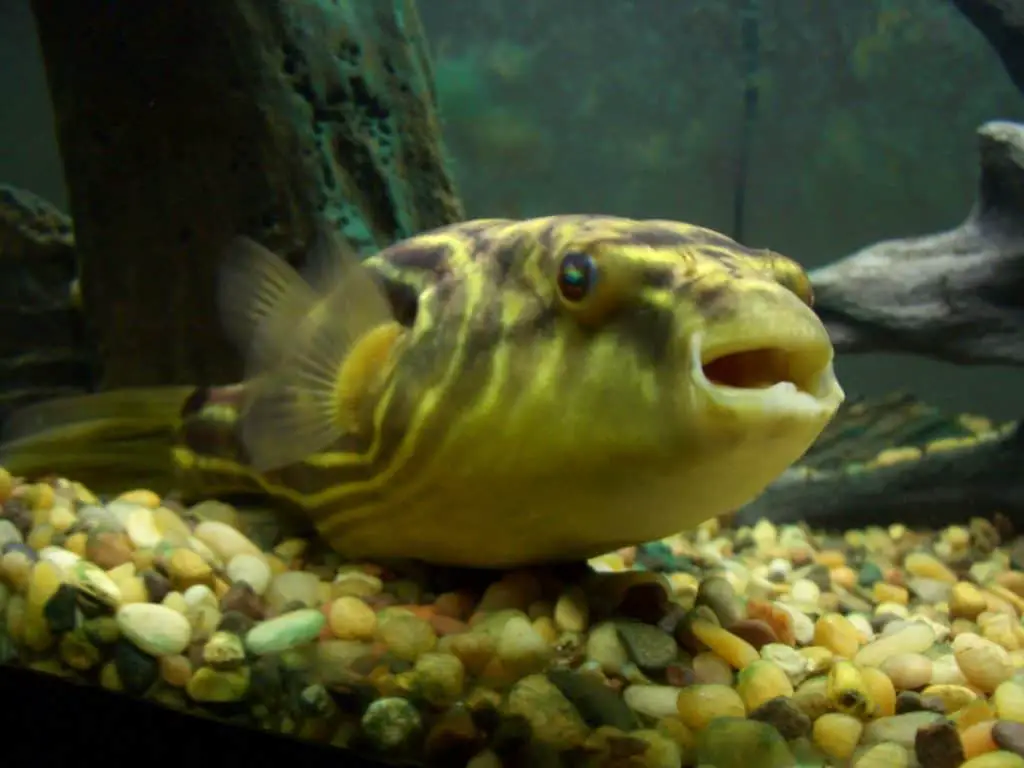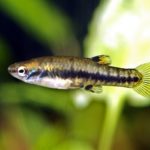Fahaka Puffer (Tetraodon lineatus), also known as Nile pufferfish, is a popular pet fish species. So, it’s essential to know that it requires special care, especially concerning food.
Pufferfish always attract people’s attention; one of the reasons is their habit of inflating in dangerous situations. Other points make these fish very interesting, the speed at which their pectoral fins move makes the fish appear to be “flying” in the water, and the constant movement of their eyes, something not very evident in other species.
In the case of the Nile pufferfish, there is still an important point, it lives 100% of its life in entirely freshwater, unlike other more widespread species marketed as freshwater pufferfish, where they need brackish water to live, like other puffers of the Tetraodon genus.

Species Summary
Spread over a wide area of the African continent, the Fahaka Puffer is a tropical freshwater pufferfish belonging to the Tetraodontidae family. The species occur in different rivers and lakes, both in densely vegetated banks and open waters.
These pufferfish reach large sizes; because of that, they need large tanks. Its aggressiveness, large size, and care with feeding are the limiting factors in keeping this animal.
They are considered extremely intelligent and curious fish, which react spontaneously to specific situations; this makes it one of the foremost sought-after pet fish. Due to their aggressiveness and size, they should be kept solitary in large aquariums.
Care Guide
Its expressive face, sometimes looking like they are smiling, and its different shape and irregular swimming are exciting attractions. They are fish with very peculiar habits, and even though they are undemanding, they need some experience from the aquarist, especially in terms of food and water quality.
It is a resilient and easy-care fish, but that does not eliminate the need for you to know the species, its habits, and behaviors in depth. Like any other species, Fahaka Puffer has its peculiarities, addressed and detailed in the following topics.
Tank Size
Fahaka are active and prominent puffers; therefore, they should inhabit large aquariums above 120 gallons, with dimensions around 48″ x 24″ x 24″. This size accommodates a specimen well. To keep a small group, I recommend a tank above 400 gallons.
Tankmates
Being a predatory fish species with a large size and very aggressive behavior, it will be challenging to keep them with other fish. If you still want to give it a try, have a very large tank with fast-swimming species and plenty of hiding places.
Same Species Tanks
Due to its behavior and large size, the species is usually kept solitary in the aquarium. There are rare and sparse reports of a few aquarists who managed to keep the species in groups in enormous aquariums and tanks. And even in a stabilized group and huge tanks, aggression is still common.
Water Parameters
They are resistant fish but do not support sudden changes in parameters. They thrive best in a narrow range of parameters. This puffer presents itself as an exclusive freshwater species and does not require any addition of salt in its environment.
The perfect temperature for its maintenance is from 75 to 79 F. The ideal pH range is between 6.5 to 7.5 and the hardness from 5 to 15°H.
This difference between hardness and pH is related to the region of origin of the specimen and demonstrates the fluctuation of parameters during the dry and rainy seasons.
What to Put in Their Tank
As for any other aquatic animal, an aquarium heater and a filtering system are essential to keep a tank with Fahaka Puffer healthy. The filtration system should be well dimensioned without creating a solid flow in the water. Due to the irregular swimming of this species, one should avoid making a lotic environment in the aquarium.
Some pufferfish have a habit of turning over the substrate and rocks in the tank; for this reason, we recommend a sandy, soft substrate and rounded stones, free from spikes that could injure the fish.
Plants can be added to the pond but will likely be nibbled on sooner or later.
The decoration of the aquarium is not critical in the maintenance of the species, but it is common to use live or plastic plants; the important thing is that you use them a lot, remembering that pufferfish need to establish territories and tall plants help a lot in this regard, breaking their line of sight and consequently reducing their aggressiveness and territorialism against other pufferfish and fish. An alternative is to build plenty of caves and similar refuges (use driftwood and rocks) to take shelter if they feel threatened or rest.
Common Diseases
Fahaka Puffer fish are incredibly disease-resistant fish, but their skin may be prone to infection because they do not have scales. By providing good quality food, keeping the water quality always in excellent condition and the aquarium free from the risk of accidents, your fish should not present any problem.
Food and Diet
This species, like other Tetraodon, is a specialized carnivore that feeds on mollusks.
Its primary diet is based mainly on mollusks, crustaceans, and fish in its natural environment.
This fish accepts high-quality commercial food for predatory fish in aquariums, especially the more rigid ones.
Live and fresh foods such as shellfish, all kinds of worms, small fish, and crustaceans such as snails and crabs are their favorite food and play an essential role in the animal’s biology. The supply of these beings is critical for their survival.
An inappropriate diet with the absence of shells or “hard” elements can cause excessive growth on the tooth plates. These plates grow constantly and must be maintained by eating these foods. Once its tooth plates are significant, the fish may not be able to open its mouth and will starve to death. If you reach this stage, there must be intervention by the aquarist by cutting the plates manually.
Fahaka Puffer fish always seem to be hungry.
Lifespan
This giant puffer fish can live for ten years in an aquarium with all the correct parameters kept stable and with optimal nutrition.
In nature, these animals are prone to live less, as they are predisposed to diseases, attacks from other animals, and environmental causes.
Appearance
They have a robust and eccentric body with various color patterns. Juveniles have a more mottled appearance, but their design becomes more striped as they grow older. Its color varies from yellow to reddish.
Its large eyes are positioned laterally on the skull, and together with its visible teeth are its most striking features. Its body is elongated with a broad, veil-shaped fin.
Size
In aquariums, they can easily reach 16 inches. A study with several specimens from the Nile River showed an average of 9 inches in a natural environment, with females showing larger sizes.
Behavior and Temperament
Fahaka Puffer are a very aggressive species with other species and with itself. Using its bony beak, it can quickly crush, kill, or tear off pieces of other fish.
They are intelligent and curious fish that carefully observe what is happening around them. They interact very well with the tank and its exterior and maintainers.
Breeding
Captive breeding doesn’t happen very often. One reason is the difficulty of keeping more than one fish in the same tank and the problem of sexing them correctly. However, even being a fish with difficult reproduction, we find reports of success in its reproduction in domestic aquariums.
The species reaches its sexual maturity around 12 months of life; when ready, the female is full of eggs and externalizes its ovipositor. The male approaches, and performing specific movements unique to the species, stays close to the female fish in a way that the sexual apparatus of the two are together, then the sperm is released along with the eggs; this process takes around 30 seconds and can be repeated several times; the female may deposit several thousand eggs. The pair do not create bonds and do not exhibit parental care.
Eggs hatch 72 to 96 hours after laying, and the fry will become free-swimming in approximately one week.
Gender Differences: Male vs. Female
There is no apparent sexual dimorphism. Thus, it will only be possible to define the sex of the fish moments before laying the eggs, with the “externalization” of the female’s ovipositor or with the female’s belly more protuberant and rounded, being full of eggs.
Fun Facts
Pufferfish are gluttonous animals, and they eat a lot. Therefore, they will generate a tremendous amount of organic load, so a good filtering system for their maintenance and regular partial water changes is essential.
During their evolution, they developed numerous defense mechanisms. In particular, we can mention its specific form of locomotion, effectively using a combination of pectoral, dorsal, anal, caudal, and propulsion fins, making its swimming very maneuverable but very slow.
The primary defense mechanism is its ability to swell/inflate quickly, filling its stomach with water, very elastic, or with air when out of the water, which can double or triple its size, which is why they were known as Puffer Fish. This means of defense can deceive a potential predator.
Some pufferfish, particularly marine species, produce a potent neurotoxin in their internal organs known as tetrodotoxin, found mainly in the ovary and liver. They can migrate small amounts into your intestines and skin into muscle and blood tissue when attacked. This neurotoxin can be lethal to most predators, including humans. Studies carried out by researchers in Nagasaki (Japan) state that pufferfish acquire the venom by consuming toxic foods such as starfish and shellfish.
In medicine, medicines derived from tetrodotoxin are under development to bring relief to those who suffer from intense chronic pain; they are being studied in experiments on cancer patients and even on drug addicts.
Its eyes can move independently, and in some species, they can even change the color or intensity of their patterns according to environmental changes and needs.
Another peculiarity is the thorns found on the skin of some species, mainly marine, which are pretty visible, transmitting a threatening and intimidating aspect to potential predators. In Tetraodon lineatus, its head and body are covered with small spines, which become more visible when the animal swells up.
This species has considerable commercial value, attracting aquarium hobbyists and the pharmaceutical industry.
References
AbouelFadl, Khaled Y., and Mahmoud MS Farrag. “Egyptian Journal of Aquatic Research.” (2020).
AbouelFadl, Khaled Y.; Farrag, Mahmoud M.S. (2020). Biology and population dynamics of the freshwater puffer fish, Tetraodon lineatus (Linnaeus, 1758), from the River Nile, Aswan, Egypt. The Egyptian Journal of Aquatic Research, (), S1687428520300789–. doi:10.1016/j.ejar.2020.09.005
Akinyi, E., et al. “Tetraodon lineatus.” The IUCN Red List of Threatened Species (2010).
Khaled Mohammed-Geba, Aldoushy A. Mahdy, Ahmed S. A. Eissa, Alaa G. M. Osman. Analysis of Population Genetics of the Endangered Nile Pufferfish Tetraodon lineatus (Linnaeus, 1758) in the Upper Egyptian River Nile. International Journal of Ecotoxicology and Ecobiology. Vol. 1, No. 2, 2016, pp. 60-66. doi: 10.11648/j.ijee.20160102.15








